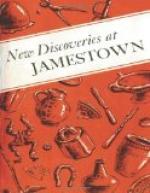METALWARE EATING AND DRINKING VESSELS
While large numbers of eating and drinking vessels made of pottery have been excavated on Jamestown Island, only a few fragments of utensils made of silver, pewter, brass, and copper were found. Metalware vessels were relatively scarce during the early years of the settlement, and their almost complete absence in the Jamestown collection may be attributed to the fact that not many of them were discarded, regardless of their worn condition. Only a few metal handles from mugs and cups, and a small number of pewter plate fragments, have been excavated.
Although no complete specimens of domestic silver and pewter eating and drinking vessels were found, 17th-century records and inventories indicate that many Jamestown families owned such wares (especially after 1630), including cups, beakers, dishes, salts, salvers, tankards, porringers, bowls, and plates.
It is of interest that 2 goldsmiths, 2 refiners, and a jeweler arrived at Jamestown in 1608 aboard the supply ship Phoenix. Although John Smith related that these artisans “never had occasion to exercise their craft,” it is possible that they made a few metal objects (such as spoons) in the capital city.
GLASS DRINKING VESSELS
Glass was made at Jamestown in 1608-09, and again in 1621-24. It was, in all probability, the first commodity made by the English in a “factory” in the New World. Many glass fragments were found at the furnace site, but none was large enough to reveal what specific glass objects were made there. It appears that drinking glasses may have been among the items manufactured.
The majority of the glass drinking vessels unearthed at Jamestown were made in England, although a few were manufactured in Germany, Italy, and the Low Countries. In the collection are fragments from goblets, beakers, bowls, and wineglasses. Four of the English wineglass stems bear makers’ seals, rare marks seldom found on English drinking vessels.
GLASS WINE AND GIN BOTTLES
These comprise a large and important part of the Jamestown collection. Literally thousands of glass fragments from these bottles have been unearthed, and by diligent and patient work a few complete wine and gin bottles have been pieced together.
The glass wine bottles were made in England. The oldest excavated, made between 1640 and 1660, have spherical bodies and tall necks. Those made between 1660 and 1680 have cup-shaped bodies with short necks. Of the period between 1680 and 1700 the neck is very short and the body is wide and squat. Insofar as is known, no glass wine bottles were used at Jamestown before 1640.
[Illustration: Glass wine bottles unearthed at Jamestown ranging in date from 1640 to 1690. Thousands of fragments of these bottles have been recovered.]




